Stem Water Content Explained
Download a PDF of this Application Note.
What is stem water content?
Stem water content refers to the amount of water inside stems, trunks, branches, twigs, etc, of plants. Stem water content is also referred to as sapwood water content, moisture content, sapwood gravimetric water content, or sapwood volumetric water content.
Stem water content may be differentiated into sapwood, heartwood water content, or a combination of sapwood and heartwood water content. Therefore, it is more precise to differentiate stem water content into sapwood or heartwood water content. The bark may also be measured as part of stem water content.
Figure 1 is an anatomical diagram of the stem showing the bark, phloem, xylem, sapwood and heartwood and the locations where water content may be estimated.
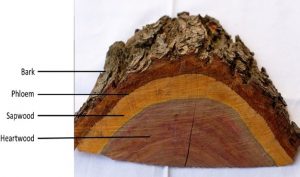
Figure 1. The anatomy of a representative dicotyledon woody stem. Typically, stem water content is measured in the sapwood and is therefore also referred to as sapwood water content. However, water content in the bark and heartwood can also be measured.
Why is stem water content important?
Stem water content is a measure of the hydration levels in stem tissues. Hydration, or the amount of water, is critical for a large range of plant physiological processes including transpiration, photosynthesis, reproduction, growth, organ development, cell structure and function, osmotic relations, and more.
Stem water content is also important for several parameters of interest to hydrologists such as storage (capacitance) and the abilities of plants to respond to soil moisture deficits, droughts and extreme weather events.
How is stem water content measured?
Stem water content is measured destructively or estimated with sensor technology.
Destructive measurements are the most accurate method to determine stem water content. But, as the name implies, it also means wounding, damaging, or harvesting the plant.
In trees, a sample is collected via a stem borer. The wet weight of the sample is quickly measured on a weigh scale. The sample is then oven dried to remove all moisture and the sample is reweighed to find the dry weight. The water content of the sample can then be calculated.
Sensor technology is an in-situ, continuous and non-destructive estimate of stem water content. Sensing technology is not a direct measurements of water content rather it is an estimate based on physical principles. This may include capacitance sensors measuring the dielectric permittivity of stems; or thermal sensors measuring the thermal properties of stems via thermal conduction. The dielectric permittivity or thermal properties of the stem are then converted to water content through a series of equations.
The Implexx Sap Flow Sensor (Figure 2) estimates stem water content via thermal properties and thermal conduction.
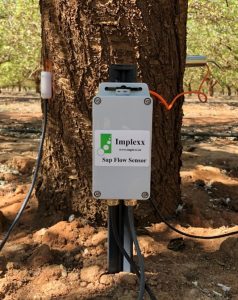
Figure 2. The Implexx Sap Flow Sensor provides in-situ, non-destructive and continuous estimates of stem water content as well as sap flow and stem temperature.
How are water content and thermal conduction related?
Thermal conduction is the movement of heat in a sample via diffusion. The sample can be anything from plant material (i.e., stem or sapwood) to soil to rocks to water to fabric to metals and more.
Thermal conduction is dependent on several parameters including the amount of heat input into the sample, maximum change in temperature, and properties of the sample including its density, its specific heat capacity, the specific heat capacity of water (or sap within plants), and, most importantly for stem water content, the water content of the sample.
How is stem water content calculated from thermal properties?
The equation for volumetric stem water content (θ, %) is:
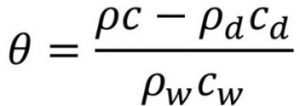 equation 1.
equation 1.
where ρc (kJ m-3) is volumetric heat capacity of the stem, ρd (kg m-3) is dry wood density, cd is heat capacity of dry wood (1.2 kJ kg-1 K-1), ρw is the density of sap (1000 kg m-3), and cw is the heat capacity of sap (4.182 kJ kg-1 K-1).
From equation 1, cd, ρw and cw are fixed parameters. Therefore, these parameters are assumed to be the same for all plants (although, strictly, these values vary slightly between species and with temperature and the careful, thorough researcher will check their own values).
The ρd parameter (denoted as DDW in the Implexx Sap Flow Sensor) is both a fixed and variable parameter. That is, ρd varies between species, varieties, individuals, and location within the plant (e.g., at the base of the trunk versus the branches). However, once wood has formed within plants ρd is then a fixed value at a specific location. That is, the density of wood does not change once it is formed. Therefore, ρd must be measured once at a location as close as possible to the sensor’s installation site.
The parameter ρc is a variable in equation 1. Therefore, an accurate measurement of ρc is required to estimate stem water content. The parameter ρc is further defined as:
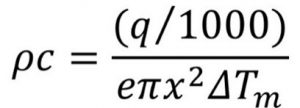 equation 2.
equation 2.
where q is the heat pulse energy (J m-1), x is the distance (m) between the heater and temperature probes, and ΔTm (K) is the maximum temperature following the heat pulse minus the pre heat pulse temperature.
The x parameter is usually assumed to be a fixed value although it can vary depending on the installation (see probe misalignment issues and application note). Additionally, x may vary over time as the plant grows, develops wounds, and undergoes other changes. Therefore, x should be carefully observed.
The q parameter is dependent on electronics and the application of a heat pulse. As q is electronically dependent it is assumed to be a fixed parameter, but it can vary with temperature and other properties. The Implexx Sap Flow Sensor measures q for every heat pulse and the value is included in the stem water content calculation.
The ΔTm parameter is the variable directly correlated with stem water content. The correlation between ΔTm and stem water content is negative where wet stems with high moisture content have relatively small ΔTm values and dry stems with low moisture content have relatively large ΔTm values.
How accurate is the Implexx Sap Flow Sensor in estimating stem water content?
The Implexx Sap Flow Sensor accurately estimates stem water content. Figure 3 shows the correlation between volumetric stem water content measured from an Implexx Sap Flow Sensor and actual volumetric stem water content measuring with a drying oven. The samples were measured from 4 different species. Analysis found that the accuracy is approximately 4%.
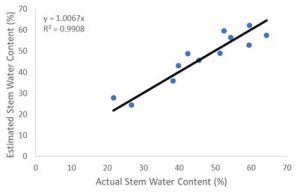
Figure 3. A comparison of actual stem water content, measured via destructive sampling technique, and estimated stem water content via the Implexx Sap Flow Sensor.
Radial measurements of stem water content
The Implexx Sap Flow Sensor can estimate stem water content at multiple depths into the stem. Known as “radial profiling”, measurements are undertaken towards the outside (“outer”) and inside (“inner”) portions of the stem (Figure 4). The 30 mm length needles of the Implexx Sap Flow Sensor have a temperature sensor (thermistor) at 10 mm (outer) and 20 mm (inner) depth. Therefore, these two measurement locations can be used to resolve stem water content at different locations within the stem’s anatomy.
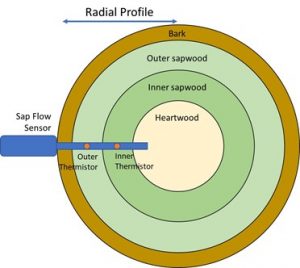
Figure 4. The radial profile of a stem is that portion from the outside of the bark to the middle of the heartwood. The radial profile may also be extended across the diameter of the stem. The Implexx Sap Flow Sensor measures at 2 locations along the radial profile: outer (towards the outside of the stem) and inner (towards the inside of the stem).
Understanding the dynamics of water content across the radial profile will provide invaluable insights to plant adaptation and physiology. For example, in some plants the inner portion of the stem, or even the bark, may be a zone of water storage (capacitance) that is important during time of soil moisture deficit. The importance of such storage, and its dynamics, can only be known if it is measured.
The high spatial resolution of the Implexx Sap Flow Sensor is a distinct advantage over other sensing technology that measure stem water content. For example, soil water content sensors that are installed inside trees, such as capacitance probes, or time domain reflectometry (TDR) probes, integrate water content measurements over the entire length of the probe. This length may be 50 mm or longer and can cross different stem tissue such as bark, sapwood and heartwood. These probes have a poor spatial resolution and misinterpretation of data may occur (Figure 5).
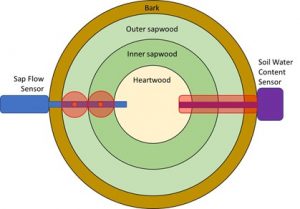
Figure 5. The spatial resolution of the Implexx Sap Flow Sensor, based on thermal properties, versus a soil water content sensor based on either capacitance or TDR. The zone of influence, or spatial resolution, is highlighted in red.
Stem water content under high sap flow conditions
The estimation of stem water content via the theory of thermal conduction assumes that there is zero thermal convection. That is, the sap, or fluid, inside the stem, during a measurement cycle, is assumed to be static or non-moving. This assumption is found in equation 1 where there is no parameter for velocity or convection.
Therefore, stem water content estimated via thermal properties is most accurate under zero, or very slow, sap flow conditions. Such conditions occur during the night, typically in the pre-dawn period approximately 1 to 2 hours prior to sunrise. It is recommended that stem water content is measured at this time.
Under high sap flow conditions, the estimation of stem water content via a thermal sensor will be drier than actual stem water content. This result is found from equation 2 where ΔTm is influenced by sap flow. Under high flow conditions, ΔTm is relatively larger due to heat convection. An increase in ΔTm causes ρc to decrease (because ΔTm is the denominator, or a parameter below the line, in equation 2). A decrease in ρc in equation 1 will lead to a smaller stem water content value.
One possible approach to estimate stem water content under high sap flow conditions is to install the probes perpendicular to the direction of sap flow (i.e., the yellow circles in Figure 6). Although, caution with this approach should be taken as this method has not been extensively researched or tested. Also, it is not possible to estimate sap flow with this style of installation.
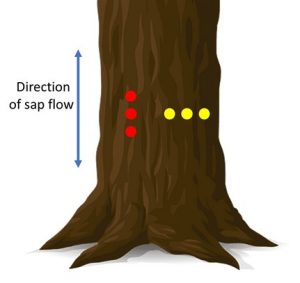
Figure 6. Under high sap flow, stem water content may be estimated by installing the sensor perpendicular to the assumed direction of sap flow. The red circles represent a typical sap flow sensor installation where the sensor is installed parallel to the direction of flow. The yellow circles represent a sensor installation perpendicular to the direction of sap flow. Caution should be exercised with this approach as it has not been extensively tested or investigated.
Negative stem water content?
The observable range of values for stem water content is between 0 % (completely dry) and 100 % (pure water). Typically, values range between 10 % and 80 % as some moisture is always retained in the stem and the stem cannot be pure water.
However, the Implexx Sap Flow Sensor may output a negative stem water content or a value greater than 100 %.
The sensor is not faulty. Rather, the parameters from equations 1 and 2 have not been configured correctly. A correct configuration will remove negative or erroneous values.
The two most important parameters from equations 1 and 2 that must be configured correctly are dry sapwood density (ρd), also known as dry density of sapwood (DDW), and the distance (x) between the heater and temperature probes. The importance of ρd to stem water content is shown in equation 1. Similarly, x is important in equation 2. The parameters ρd and x are explained in detail in the section above, “How is stem water content calculated from thermal properties?”.
Further information, and how to measure pd and x, are provided in the application notes “How to Measure DDW Sapwood Dry Density”, “Quick Start Guide - Correction for Probe Misalignment” and "Correction Factors for Sap Flow Measurements".
References
Campbell et al., 1991, Soil Science Society of America Journal, 55, 291-293.
Forster, 2020, Tree Physiology, 40, 683-694. doi:10.1093/treephys/tpaa009
He et al., 2018, Reviews of Geophysics, 56, 567-620. doi: 10.1029/2017RG000584
López-Bernal et al., 2012, Tree Physiology, 32, 1420-1429. doi: 10.1093/treephys/tps101
Further Information
